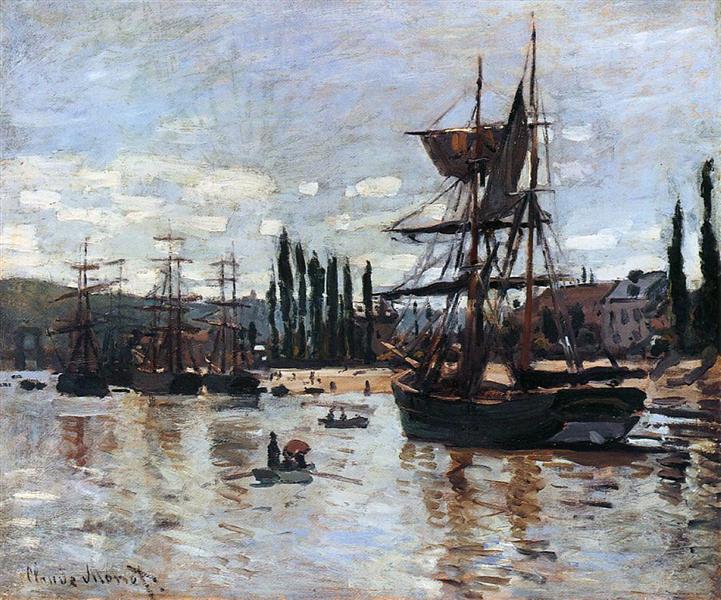Descriere
Claude Monet’s Boats at Rouen, painted in 1872, stands as a vibrant testament to the artist’s innovative approach to light and colour, key to the evolution of Impressionism. In this painting, Monet captures a fleeting moment in the port of Rouen, a place that became a recurring space in his work, where boats seem to float in an environment of peace and movement. The composition presents a series of anchored vessels, made up of a palette of blues and greys that dialogue with the changing sky and reflections on the water.
Compositionally, the work is arranged in such a way that the observer feels the presence of the different vessels while the enveloping mist seems to create an atmosphere of intimacy. The vessels, although representative, lack the rigorous definition of form, demonstrating Monet's interest in exploring beyond literal representation. The mixture of quick brushstrokes and splashes of color acts both to build the forms and to suggest the movement of water. One cannot help but experience the sensation of a space where the ephemeral mixes with the eternal; light and water become protagonists in the painting's visual narrative.
The use of color in “Boats at Rouen” is exceptionally significant. Monet uses shades of blue, green, and gray, with subtle hints of red and yellow, which bring a sense of luminosity to the work. This choice of color bones in the background and sky plays a crucial role in creating an atmosphere that evokes a sense of calm and serenity, contrasting with the energy of boats that are often associated with commerce and movement. Furthermore, it is fascinating to observe how Monet allows the colors to blend visually from a distance, a technique that results in a less literal and more emotional representation.
In terms of characters, Boats at Rouen focuses more on the boats and the landscape than on the human figure. This was part of the impressionist approach of Monet and his contemporary, Edgar Degas, who preferred to depict everyday life and nature in a way that privileged sensory perception over traditional narrative. By not including human figures, Monet invites the viewer to connect with the environment, suggesting a dialogue between nature and man in the maritime space.
This type of work fits into the broader quest of Impressionism, where artists sought to capture not just the image, but also the visual and emotional experience of a moment. Monet, through his loose technique and ability to transform the everyday into something sublime, establishes himself as a pioneer in the exploration of light and its interaction with form. “Boats at Rouen” represents an evolution in his artistic practice, a step on the march towards his famous Rouen Cathedral series, where the use of sunlight at different times of the day allows for an even more complex experience of visual perception.
Thus, this work is not just a mere representation of a maritime landscape, but a testimony to the changing perception, ephemeral beauty and ambiguity of the human experience. The interconnection between the boat, the water and the sky becomes a reflection on the passage of time and the very nature of observation, themes that continue to resonate in contemporary art. “Boats in Rouen” remains a key piece in the history of art, showing Monet’s journey towards a new way of seeing and perceiving the world.
KUADROS ©, a famous painting on your wall.
Hand-made oil painting reproductions, with the quality of professional artists and the distinctive seal of KUADROS ©.
Painting reproduction service with satisfaction guarantee. If you are not completely satisfied with the replica of your painting, we will refund 100% of your money.

